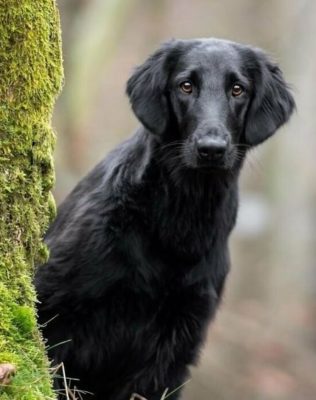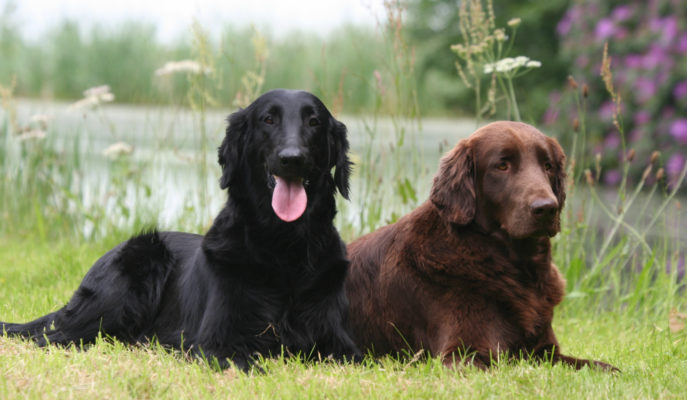Flat-coated Retriever

The Flat-coated Retriever is a consummate hunting companion, the most loyal friend, and a true family member. He is very contactable and needs constant attention from his owner. He is extremely fond of children, ready to frolic, play and run for hours on end. Not at all aggressive, which means he won’t be a good guard at home.
Table of Contents
Breed Information
| Another Name | – |
| Origin | England |
| Height | Males 59-61.5 cm Females 56.5-59 cm |
| Weight | 25-36 kg |
| Fur | Medium |
| Color | Black, liver |
| Lifespan | 11-14 years |
| FCI Classification | Retrievers – Flushing Dogs – Water Dogs |
| Group | Hunting dogs |
| Price | From $500 |
Breed Photos
Origin History
The formation of the Flat-coated Retriever breed began in the mid-nineteenth century. At the time, the breed was the most used hunting dog in Great Britain. There is no officially confirmed data on the origin of the Flat-coated Retriever. There are several popular theories. The breed was promoted by Canadian sailors who brought the dogs with them and left them in British ports. It is generally believed that the Labrador Retriever has involved inbreeding. From him, the Flat-coated Retriever inherited a love of swimming. The Irish Setter, from which the breed got its incredible excitement for hunting and its developed sense of smell.
The Flat-coated Retriever was first introduced as a separate breed at a show in England in 1860. In 1898 the Flat-coated Retriever was entered in the studbooks of the English Kennel Club. During the First World War, the Flat-coated Retriever was used as a helper for the soldiers, as a service dog. The first standard the breed received from the English Kennel Club in 1915. The Woolly Retriever was officially recognized by the Fédération Cynologique Internationale in 1935.
Appearance
The main difference between the Curly-coated Retriever and its closest cousin, the Labrador, is that the Flat-coated Retriever is more agile, faster, and more maneuverable. These qualities made experienced hunters take a closer look at the breed and make their choice in its favor. The Flat-coated Retriever’s appearance speaks for itself – it is a powerful, determined dog with an easy gait and forward drives.
The body of the dog is strong and athletic. The body is elongated in shape. The head is also slightly elongated; the skull is moderately wide. The transition from forehead to muzzle is smooth. The eyes are medium-sized, oval in shape, and dark in color. The gaze is focused and affectionate. Soft floppy ears, adjoining the head, of medium size. Deep and broad chest. Strong back. Straight limbs with well-developed musculature. The tail is planted high, straight, and tapered to the end.
The coat is of medium length, thick and shiny. It is silky to the touch. At the bottom of the belly, the paws and tail hair are longer than the rest of the body. Only one-color, black or liver color, is allowed. There is also a pale color, but according to the standard, it is considered an outlier.
Character
The Flat-coated Retriever is a consummate hunting companion, the most loyal friend, and a true family member. He is very contactable and needs constant attention from his owner. He is extremely fond of children, ready to frolic, play and run for hours on end. Not at all aggressive, which means he won’t be a good guard at home. The Flat-coated Retriever is too kind; the only thing it can do to a stranger has sniffed him thoroughly and barked slightly. But he can’t frighten or chase away a foe. It also refers to the socially adapted dogs.
The Flat-coated Retriever’s relationship with other animals is balanced and friendly. Suitable for housing both in a spacious country house and in an apartment. But only if you can provide the pet with long walks and adequate exercise.
Care
You won’t have to worry about caring for a Flat-coated Retriever. Just follow the standard hygiene guidelines. A Flat-coated Retriever’s coat is manageable and usually does not tangle. But still requires regular brushing, about three times a week. Your pet’s ears need a thorough exam, so be sure to clean them several times a week. During water hunting or bathing in bodies of water, inspect them daily. Also, be sure to wipe their ears dry to prevent inflammation from accumulated moisture.
Active dogs tend to clip their claws on their own, but if that’s not enough, trim them monthly. It is important to note that black Flat-coated Retrievers do not tolerate heat and are at risk of heatstroke.
Training
The retriever’s sharp mind combined with curiosity and a desire to please their owners yields good training results. The Flat-coated Retriever is regarded as the fastest of the speedy breeds among hunting dogs. Owners praise it for its quick reactions and an excellent memory. And also for its responsiveness and attention to obeying commands. The Flat-coated Retriever is not prone to showing a dominant stance. Can be stubborn only when abused. Remember, this approach is inappropriate and will make your dog an inadequate and unmanageable animal.
Common Diseases
Representatives of the breed, in most cases, do not have a predisposition to serious diseases. However, some breeders note the risk of such pathologies:
- deafness;
- stomach congestion;
- hip and elbow dysplasia;
- ophthalmic diseases and infections;
- diabetes mellitus;
- epilepsy;
- cancerous tumors (the risk of occurrence is high only in older dogs).
Nutrition
The Flat-coated Retriever diet should be balanced and chosen based on your pet’s activity and workload. The Flat-coated Retriever is not prone to allergic reactions and is not fussy about food. Able to adapt to any diet offered.
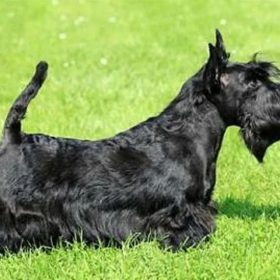 Scottish Terrier
Scottish Terrier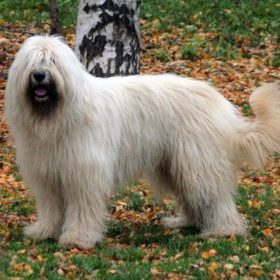 South Russian Ovcharka
South Russian Ovcharka Italian Greyhound
Italian Greyhound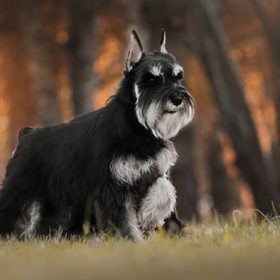 Miniature Schnauzer
Miniature Schnauzer Whippet
Whippet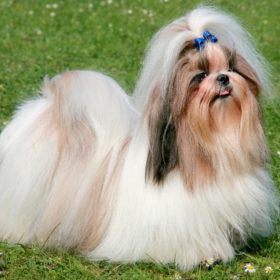 Shih Tzu
Shih Tzu
